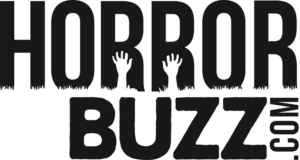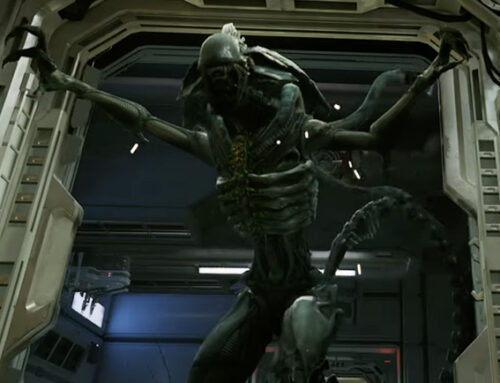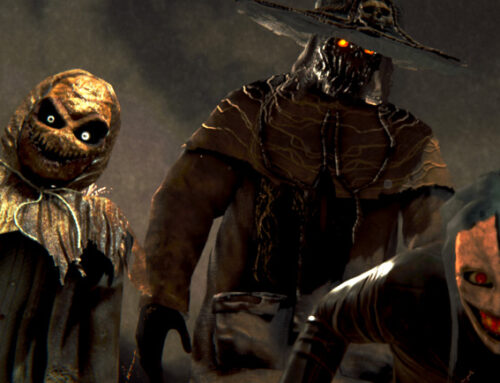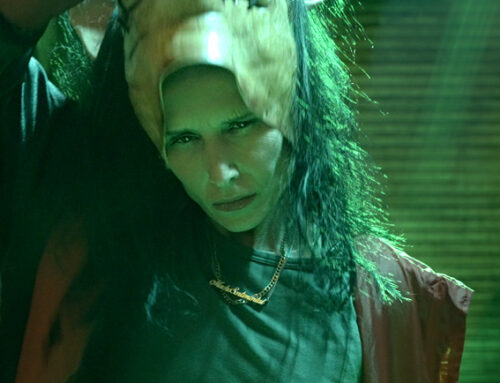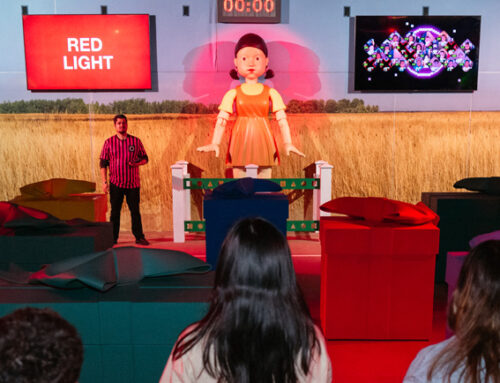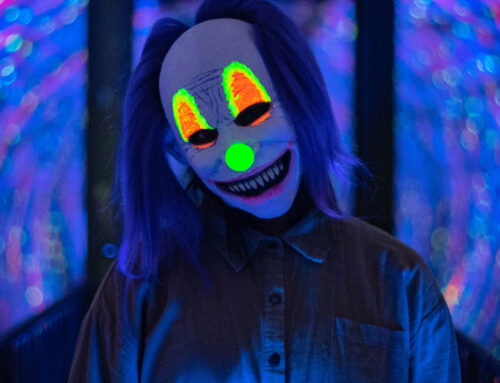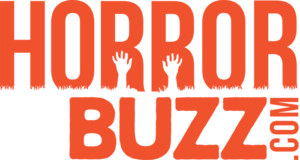What if there was a device that could cure any phobia by placing the patient in a controlled, virtual environment? What if such a device backfired, and forced its unwitting victim into a world of endless terror?
This is the reality that Virtual Screams presents, brought to life through the power of virtual reality. Virtual Screams features a growing array of spine-chilling scenarios, including a live burial, a face-to-face encounter with a hungry shark, and a bumpy ride through arachnophobia hell. After presenting a demo at last year’s ScareLA, the developers will be bringing the experience to Midsummer Scream at the end of this month. I recently got to sit down with lead developer Ryan Batcheller to discuss the project and his views on VR horror.

Could you give us a little summary of what Virtual Screams is all about?
“Virtual Screams is about haunted virtual experiences. It’s sort of like the Twilight Zone, it’s one name with multiple stories underneath. Right now we have Phobos laboratories which is basically a fear simulator experiment gone wrong, but in the future we’ll have a number of experiences that won’t be related to each other, but will all fall under the banner of Virtual Screams. Virtual, interactive entertainment is what I guess you would call it.”
How long have you been a developer and what projects have you been working on up to this point?
“In video games I started about 10 1/2 years ago, I work at a company called Jumpstart and we do Jumpstart Math Blaster and educational games. Currently and for about the last 4 years now I’ve been working on School Dragons which is in partnership with Dreamworks. How to Train Your Dragon is the franchise we’re working with and we’re doing an educational MMO, which is kind of a combination of How to Train Your Dragon and Harry Potter. It’s a school where kids go to and they all get dragons and learn about science. That’s what I do as my day job.”
When did you start work on Virtual Screams?
“I started around 2012 as sort of a side projects because I’m really into theme parks, Halloween, I always love going to all the Halloween events. So I wanted to do something that was more interactive and Halloween related. Originally it was just going to be something that you would do in your web browser, it was just going to be a little haunted house. After about a year of working on it, all of a sudden the Oculus Rift Kickstarter showed up and the idea of real virtual reality kind of changed everything. We started to get a lot more momentum that we could really do this in virtual reality. As soon as I could I went out and got a development kit so I could start developing my ideas with the headset and make some true virtual reality. After that I was hooked, there is something about making an environment and feeling like you’re able to physically walk through it. There’s such a sense of presence that it’s perfect for horror. If I put a monster right next to the camera, when you have that headset on it feels like it’s right there in your face. It’s pretty amazing, I think it’s a perfect platform for horror experiences.”
 What’s your horror background, are there any particular films or genres that have had an influence on your creative process?
What’s your horror background, are there any particular films or genres that have had an influence on your creative process?
“Oh man, I like a lot of films out there, Texas Chainsaw Massacre, Nightmare on Elm St., Friday the 13th, Saw, all sorts of slasher movies. I’m more of a fan of the theme parks I think. I like immersive entertainment and some of the mazes they’ve done at Knott’s Scary Farm and Universal have been so amazing to me; to me that’s more of what I enjoy versus just watching a movie. To live it, to go through theose environments with the special effects-that’s what I prefer as a horror fan.”
Any haunts or mazes that have stood out in particular?
“I grew up going to Knott’s Scary Farm since I was in high school, so there’s a lot of nostalgia there for me. I’d have to say that’s my favorite, nothing beats Ghost Town and going through Fog Alley, still one of the coolest things out there. Universal though, has done some amazing stuff, they don’t usually have as many mazes, but some of the IPs they’ve gotten and some of the stuff they’ve done in recent years has been amazing. I really like the Alien vs. Predator maze, it felt like those were movie quality sets. If I had to pick one though, it’d be Knott’s, that’s the original and the one I’ll always have the most nostalgia for, I guess.”
What would you say are some of the benefits or drawbacks of a virtual vs. a traditional haunt experience, either as a creator or as an enthusiast?
“The great thing about a virtual space is I don’t have to worry about real estate or having actual room. In a traditional haunt they have to do what they want in x amount of space or work around what they have available. I can build anything I want, the only limit is my technical ability. The spider cave is massively huge, there is no way in real life anyone would be able to build something that big without spending a billion dollars. There’s other things like safety considerations, I don’t have to put any rails in. Nothing is ever going to beat reality I don’t think, but as virtual reality keeps evolving it’s going to get pretty close. Maybe some day we’ll have something we can stick in your nose to give you the authentic smell of the smoke, but I think for right now from a creative standpoint there is a lot more freedom in virtual reality and you don’t have all those practical problems.”
What would you say is the formula for fear, and is there anything that works particularly well in VR?
“Putting something directly in the character’s face is definitely extremely effective. It’s all about misdirection and blackness and then lights on and suddenly something’s in your face. I’ll get scared sometimes even of the stuff I’ve made, because when somethings that close to your face it’s startling. That sense of presence you have in VR is amazing, you put something in someone’s face and it really feels like it’s right there. I’m always coming up with new ideas and me and some of the guys I’m working with are always coming up with new ideas for what we can do differently, to set ourselves apart. Right now we’re doing a lot of jump scares, a lot of misdirection, making them look over one way and suddenly there’s a monster right there with a musical sting. Or sometimes we just creep people out, like with the burial with the coffin getting tighter and tighter, it’s not necessarily a jump scare, it’s just a really creepy feeling that you can only get while wearing the headset. Showing it on a screen really isn’t all that effective, but when you have the headset on you feel like you’re in that box and it keeps getting tighter, that was really freaking people out. I really like showing it to people at conventions and watching them go through the experience, sometimes we’ll films them to see what they react to, it’s interesting to see what scares people and doesn’t scare other people.”
Where do you see VR horror going in the future?
“It’s tough to say because it’s so early on right now. There’s a place called The Void where you walk through mazes and the mazes are just plain walls, but you have a headset on and the headset projects a digital mapping on these mazes and the room can be reconfigured into a bunch of configurations. That can be a horror experience or something more like a swords & sorcery fantasy experience. I think something like that, combining the virtual attraction with a walk-through experience, I can see those being really big. Having other sensory input, having smells or a chair where you could program movement, but that’s going to be more toward the high-end user that can afford that sort of thing. For me, I just like to so more creative, story-driven experiences. So it’s scary, but I like to do fun scary, not crap your pants scary. I want people to have some jumps, but also have some laughs, I don’t want to just go for the people that want to be scared really bad. I’m looking for a more general audience that enjoys a good scare but also enjoys a quality interactive experience.”
What is the long-term vision for Virtual Screams?
“This is my first time developing for VR, and we’re doing some stuff where I work for VR, so we’ll probably be on mobile devices like Google Cardboard. I’d like to get Virtual Screams on the mobile market, get it out there first and then just keep going. For me Virtual Screams is my life-long journey. If it becomes a full-time job at some point, awesome. I’m hoping to do a new experience every year at least, every Halloween. I don’t plan on stopping anytime soon, to me this is it, this is my thing. I just want to keep improving and evolving and see where it goes.”
Is Virtual Screams exclusive a single-player experience, or would you consider looking into multiplayer in the future?
“That’s the big question right now. Everything we’re currently doing is a single-player experience. Some developers right now are doing interactive chat rooms, where everyone has their avatar and can talk to each other. I’m not sure about the issues with multiplayer, right now the big thing with VR is frame rate, you need a really high frame rate for VR, so you want to avoid issues like dropped frames if you have too many players in one experience. As VR becomes more established I can see there being cool multiplayer experience,s but you want to avoid making people sick with poor performance, but that might be a few years off. Personally I think it’s scarier when you’re by yourself. If you’re going to a theme park and you’re surrounded by a big group of people, it’s less scary. Being in there by yourself is a whole different experience. What I have thought about doing is creating an experience that gets scarier and scarier and there’s more challenging rooms to get through and you could compete to last the longest among your friends on Facebook.”
Any advice for people looking to get involved with developing VR horror experiences?
“Just make sure it runs well. The trick is to make art that runs fast, optimizing your graphics and your textures. So I’d say the key is to keep things as simple as possible to maintain that high frame rate. That’s the key to making a good experience for your player. Keep testing and keep making adjustments until it feels right.”
How did you initially get involved with Midsummer Scream?
“I first got into ScareLA, and as soon as I found they were going to do this other experience I contacted them again to see how I could be a part of Midsummer Scream. Midsummer Scream is a lot closer for me being out in Orange County, so it sounds like it’s going to be fun to be a part of.”
We certainly look forward to seeing what Ryan has up his sleeve for the future of Virtual Screams. Come by his booth and check it out for yourself at Midsummer Scream, happening July 30-31 at the Long Beach Convention Center. For more information go to VirtualScreams.com or follow the project on Facebook.
